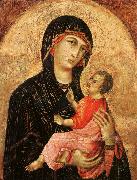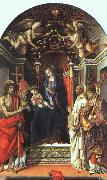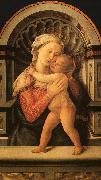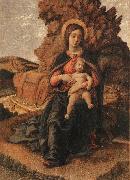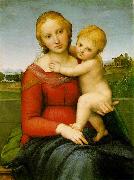
|
Duccio di Buoninsegna
|
|||
|
|
|||
| 1255-1318 Italian Duccio di Buoninsegna Locations Italian painter. He was one of the most important painters of the 14th century and like his slightly younger contemporary, Giotto, was a major influence on the course of Italian painting. An innovator, he introduced into Sienese painting new altarpiece designs, a dramatic use of landscape, expressive emotional relationships, extremely complex spatial structures and a subtle interplay of colour. His most important and revolutionary work, the Maeste for Siena Cathedral, was never matched during the 14th century, if at all, and his influence lasted well into the 15th century. | |||
|
|
|||
|
Madonna and Child Duccio di Buoninsegna14.jpg Painting ID:: 271 |
Pinacoteca, Siena | ||
|
|
|||
|
Filippino Lippi
|
|||
|
|
|||
| Italian 1457-1504 Filippino Lippi Galleries Born Filippo Lippi in Prato (Tuscany), the illegitimate son of the painter Fra Filippo Lippi and nun Lucrezia Buti, Filippino first trained under his father. They moved to Spoleto, where Filippino served as shop adjuvant in the construction of the Cathedral there. When his father died in 1469, he completed the frescos with Storie della Vergine (Histories of the Virgin) in the cathedral. Filippino Lippi completed his apprenticeship in the workshop of Botticelli, who had been a pupil of Filippino's father. In 1472, Botticelli also took him as his companion in the Compagnia di San Luca. His first works greatly resemble those of Botticelli's, but with less sensitivity and subtlety. The very first ones (dating from 1475 onwards) were initially attributed to an anonymous "Amico di Sandro" ("Friend of Botticelli"). Eventually Lippi's style evolved into a more personal and effective one in the years 1480-1485. Works of the early period include: the Madonnas of Berlin, London and Washington, the Journeys of Tobia of the Galleria Sabauda in Turin, Italy, the Madonna of the Sea of Galleria dell'Accademia and the Histories of Ester. Together with Perugino, Ghirlandaio and Botticelli, Lippi worked on the frescoed decoration of Lorenzo de Medici's villa at Spedaletto. On December 31, 1482 he was commissioned to work on a wall of Sala dell'Udienza of Palazzo Vecchio in Florence (a work never begun). Soon after (probably in 1483-1484) he was called to complete Masaccio's decoration of Brancacci Chapel in the church of the Carmine, left unfinished by the artist's death in 1428 . Here he realized the Stories of Saint Peter on the following frescoes: Quarrel with Simon Magus in face of Nero, Resurrection of Teophilus' Son, Saint Peter Jailed, Liberation and Saint Peter's Crucifixion. The work on the Sala degli Otto di Pratica, in the Palazzo Vecchio, started on February 20, 1486. It is now in the Uffizi Gallery. In the same years Piero di Francesco del Pugliese asked him to paint the altarpiece with Apparition of the Virgin to St. Bernard, now in the Badia Fiorentina, Florence. This is Lippi's most popular picture: a composition of unreal items, with its very particular elongated figures, backed by a phantasmagorical scenario of rocks and almost anthropomorphic trunks. The work can be dated to the 1480-1486 years. Eventually he worked for Tanai de' Nerli in the Saint Spirit's Church. On April 21, 1487, Filippo Strozzi asked him to decorate the family chapel in Santa Maria Novella with the Stories of St. John Evangelist and St. Philip. He worked on this piece intermittently, only completing it in 1503, after the customer's death. The windows with musical themes, also designed by Filippino, were completed between June and July 1503. These paintings can be seen as a mirror of the political and religious crisis in Florence at the time: the theme of the fresco, the clash between Christianity and Paganism, was hotly debated in the Florence of Girolamo Savonarola. Filippino showed his characters in a landscape which recreated the ancient world in its finest details, showing the influence of the Grottesco style he had seen in his journey to Rome. He created in this way an "animated", mysterious, fantastic but also disquieting style, showing the unreality of something as a nightmare. In this way, Filippino portrayed ruthless executioners deformed by grim faces, who raged against the Saints. In the scene with St. Philip expelling a monster from the temple, the statue of the pagan god is a living figure which seems to dare the Christian saint. In 1488, Lippi moved to Rome, where Lorenzo de' Medici had advised Cardinal Oliviero Carafa to entrust him the decoration of the family chapel in Santa Maria sopra Minerva. These frescoes show a new kind of inspiration, quite different from the earlier works, but confirm his continued research on the themes of the Ancient era. Lippi finished the cycle by 1493. Lippi's return to Florence is variously assigned to the years going from 1491 to 1494 . Works of this period include: Apparition of Christ to Madonna (1493, now in Munich), Adoration of the Magi (1496, for the church of San Donato in Scopeto, now in the Uffizi), Sacrifice of Lacoön (end of the century, for the villa of Lorenzo de' Medici at Poggio a Caiano), St. John Baptist and Maddalena (Valori Chapel in San Procolo, Florence, inspired in some way to Luca Signorelli's art). He also worked outside of his mother-country, namely on the Certosa of Pavia and in Prato, where in 1503 he completed the Tabernacle of the Christmas Song, now in the City Museum; in 1501 Lippi realized the Mystic Wedding of St. Catherine for the Basilica of San Domenico in Bologna. Lippi's last work is the Deposition for the Santissima Annunziata church in Florence, which at his death in April 1504 was unfinished. He was so renowned that all the workshops of the city closed on the day of his burial. | |||
|
|
|||
|
Madonna and Child Filippino Lippi12.jpg Painting ID:: 2554 |
1486 | ||
|
|
|||
|
Fra Filippo Lippi
|
|||
|
|
|||
| Italian 1406-1469 Fra Filippo Lippi Galleries Lippi was born in Florence to Tommaso, a butcher. Both his parents died when he was still a child. Mona Lapaccia, his aunt, took charge of the boy. In 1420 he was registered in the community of the Carmelite friars of the Carmine in Florence, where remained until 1432, taking the Carmelite vows in 1421 when he was sixteen. In his Lives of the Artists, Vasari says: "Instead of studying, he spent all his time scrawling pictures on his own books and those of others," The prior decided to give him the opportunity to learn painting. Eventually Fra Filippo quit the monastery, but it appears he was not released from his vows; in a letter dated 1439 he describes himself as the poorest friar of Florence, charged with the maintenance of six marriageable nieces. In 1452 he was appointed chaplain to the convent of S. Giovannino in Florence, and in 1457 rector (Rettore Commendatario) of S. Quirico in Legania, and made occasional, considerable profits; but his poverty seems chronic, his money being spent, according to one account, in frequent amours. Vasari relates some romantic adventures of Fra Filippo that modern biographers are not inclined to believe. Except through Vasari, nothing is known of his visits to Ancona and Naples, nor of his capture by Barbary pirates and enslavement in Barbary, where his skill in portrait-sketching helped to release him. From 1431 to 1437 his career is not accounted for. Portrait of a Man and Woman at a Casement , c. 1440 Metropolitan Museum of Art, New York City.In June 1456 Fra Filippo is recorded as living in Prato (near Florence) to paint frescoes in the choir of the cathedral. In 1458, while engaged in this work, he set about painting a picture for the convent chapel of S. Margherita of Prato, where he met Lucrezia Buti, the beautiful daughter of a Florentine, Francesco Buti; she was either a novice or a young lady placed under the nuns' guardianship. Lippi asked that she might be permitted to sit for the figure of the Madonna (or perhaps S. Margherita). Under that pretext, Lippi engaged in sexual relations with her, abducted her to his own house, and kept her there despite the nuns' efforts to reclaim her. The result was their son Filippino Lippi, who became a painter no less famous than his father. Such is Vasari's narrative, published less than a century after the alleged events; it is not refuted by saying, more than three centuries later, that perhaps Lippo had nothing to do with any such Lucrezia, and perhaps Lippino was his adopted son, or only an ordinary relative and scholar. The argument that two reputed portraits of Lucrezia in paintings by Lippo are not alike, one as a Madonna in a very fine picture in the Pitti gallery, and the other in the same character in a Nativity in the Louvre, comes to very little; and it is reduced to nothing when the disputant adds that the Louvre painting is probably not done by Lippi at all[clarification needed]. Besides, it appears more likely that not the Madonna in the Louvre but a S. Margaret in a picture now in the Gallery of Prato is the original portrait (according to tradition) of Lucrezia Buti. The frescoes in the choir of Prato cathedral, which depict the stories of St John the Baptist and St Stephen on the two main facing walls, are considered Fra Filippo's most important and monumental works, particularly the figure of Salome dancing, which has clear affinities with later works by Sandro Botticelli, his pupil, and Filippino Lippi, his son, as well as the scene showing the ceremonial mourning over Stephen's corpse. This latter is believed to contain a portrait of the painter, but there are various opinions as to which is the exact figure. On the end wall of the choir are S. Giovanni Gualberto and S. Alberto, while the vault has monumental representations of the four evangelists. The close of Lippi's life was spent at Spoleto, where he had been commissioned to paint, for the apse of the cathedral, scenes from the life of the Virgin. In the semidome of the apse is Christ crowning the Madonna, with angels, sibyls and prophets. This series, which is not wholly equal to the one at Prato, was completed by Fra Diamante after Lippi's death. That Lippi died in Spoleto, on or about the 8th of October 1469, is a fact; the mode of his death is a matter of dispute. It has been said that the pope granted Lippi a dispensation for marrying Lucrezia, but before the permission arrived, Lippi had been poisoned by the indignant relatives of either Lucrezia herself or some lady who had replaced her in the inconstant painter's affections. This is now generally regarded as a fable, and indeed, a vendetta upon a man aged sixty-three for a seduction committed at the age of fifty-two seems hardly plausible. Fra Filippo lies buried in Spoleto, with a monument erected to him by Lorenzo the Magnificent; he had always been zealously patronized by the Medici family, beginning with Cosimo de Medici. Francesco di Pesello (called Pesellino) and Sandro Botticelli were among his most distinguished pupils. The altarpiece Lippi painted in 1441 for the nuns of S. Ambrogio is now a prominent attraction in the Academy of Florence, and was celebrated in Browning's well-known poem. It represents the coronation of the Virgin among angels and saints, including many Bernardine monks. One of these, placed to the right, is a half-length portrait of Lippo, pointed out by the inscription perfecit opus upon an angel's scroll. The price paid for this work in 1447 was 1200 Florentine lire, which seems surprisingly large. Selfportait with pupilsFor Germiniano Inghirami of Prato he painted the Death of St. Bernard. His principal altarpiece in this city is a Nativity in the refectory of S. Domenico ?? the Infant on the ground adored by the Virgin and Joseph, between Saints George and Dominic, in a rocky landscape, with the shepherds playing and six angels in the sky. In the Uffizi is a fine Virgin adoring the infant Christ, who is held by two angels; in the National Gallery, London, a Vision of St Bernard. The picture of the Virgin and Infant with an Angel, in this same gallery, also ascribed to Lippi, is disputable. Filippo Lippi died in 1469 while working on the frescos Storie della Vergine (Scenes of the life of the Virgin Mary, 1467 - 1469) in the apse of the Spoleto Cathedral. The Frescos show the Annunciation, the Funeral, the Adoration of the Child and the Coronation of the Virgin. A group of bystanders at the Funeral includes a self-portrait of Lippi together with his son Fillipino and his helpers Fra Diamante and Pier Matteo d'Amelia. Lippi was buried on the right side of the transept. The frescos were completed by Filippino Lippi, who also designed the funerary monument for his father. Although it was commissioned by Lorenzo de Medici it was not actually made until 1490 by an unknown Florentine sculptor. | |||
|
|
|||
|
Madonna and Child Fra Filippo Lippi1.jpg Painting ID:: 2558 |
Palazzo Medici Riccardi, Florence | ||
|
|
|||
|
Andrea Mantegna
|
|||
|
|
|||
| Italian 1431-1506 Andrea Mantegna Locations Mantegna was born in Isola di Carturo, close to Padua in the Republic of Venice, second son of a carpenter, Biagio. At the age of eleven he became the apprentice of Francesco Squarcione, Paduan painter. Squarcione, whose original vocation was tailoring, appears to have had a remarkable enthusiasm for ancient art, and a faculty for acting. Like his famous compatriot Petrarca, Squarcione was something of a fanatic for ancient Rome: he travelled in Italy, and perhaps Greece, amassing antique statues, reliefs, vases, etc., forming a collection of such works, then making drawings from them himself, and throwing open his stores for others to study. All the while, he continued undertaking works on commission for which his pupils no less than himself were made available. San Zeno Altarpiece, (left panel), 1457-60; San Zeno, VeronaAs many as 137 painters and pictorial students passed through Squarcine's school, which had been established towards 1440 and which became famous all over Italy. Padua was attractive for artists coming not only from Veneto but also from Tuscany, such as Paolo Uccello, Filippo Lippi and Donatello. Mantegna's early career was shaped indeed by impressions of Florentine works. At the time, Mantegna was said to be a favorite pupil; Squarcione taught him the Latin language, and instructed him to study fragments of Roman sculpture. The master also preferred forced perspective, the lingering results of which may account for some Mantegna's later innovations. However, at the age of seventeen, Mantegna separated himself from Squarcione. He later claimed that Squarcione had profited from his work without paying the rights. His first work, now lost, was an altarpiece for the church of Santa Sofia in 1448. The same year Mantegna was called, together with Nicol?? Pizolo, to work with a large group of painters entrusted with the decoration of the Ovetari Chapel in the apse of the church of Eremitani. It is probable, however, that before this time some of the pupils of Squarcione, including Mantegna, had already begun the series of frescoes in the chapel of S. Cristoforo, in the church of Sant'Agostino degli Eremitani, today considered his masterpiece. After a series of coincidences, Mantegna finished most of the work alone, though Ansuino, who collaborated with Mantegna in the Ovetari Chapel, brought his style in the Forl?? school of painting. The now censorious Squarcione carped about the earlier works of this series, illustrating the life of St James; he said the figures were like men of stone, and had better have been colored stone-color at once. This series was almost entirely lost in the 1944 Allied bombings of Padua. The most dramatic work of the fresco cycle was the work set in the worm's-eye view perspective, St. James Led to His Execution. (For an example of Mantegna's use of a lowered view point, see the image at right of Saints Peter and Paul; though much less dramatic in its perspective that the St. James picture, the San Zeno altarpiece was done shortly after the St. James cycle was finished, and uses many of the same techniques, including the classicizing architectural structure.) San Luca Altarpiece, 1453; Tempera on panel; Pinacoteca di Brera, MilanThe sketch of the St. Stephen fresco survived and is the earliest known preliminary sketch which still exists to compare to the corresponding fresco. Despite the authentic look of the monument, it is not a copy of any known Roman structure. Mantegna also adopted the wet drapery patterns of the Romans, who derived the form from the Greek invention, for the clothing of his figures, although the tense figures and interactions are derived from Donatello. The drawing shows proof that nude figures were used in the conception of works during the Early Renaissance. In the preliminary sketch, the perspective is less developed and closer to a more average viewpoint however. Among the other early Mantegna frescoes are the two saints over the entrance porch of the church of Sant'Antonio in Padua, 1452, and an altarpiece of St. Luke and other saints (at left) for the church of S. Giustina, now in the Brera Gallery in Milan (1453). As the young artist progressed in his work, he came under the influence of Jacopo Bellini, father of the celebrated painters Giovanni and Gentile, and of a daughter Nicolosia. In 1453 Jacopo consented to a marriage between Nicolosia to Mantegna in marriage. | |||
|
|
|||
|
Madonna and Child Andrea Mantegna4.jpg Painting ID:: 2718 |
1506 Galleria degli Uffizi, Florence | ||
|
|
|||
|
Raphael
|
|||
|
|
|||
| Italian High Renaissance Painter, 1483-1520 Raphael Sanzio, usually known by his first name alone (in Italian Raffaello) (April 6 or March 28, 1483 ?C April 6, 1520), was an Italian painter and architect of the High Renaissance, celebrated for the perfection and grace of his paintings and drawings. Together with Michelangelo and Leonardo da Vinci, he forms the traditional trinity of great masters of that period. Raphael was enormously productive, running an unusually large workshop, and, despite his early death at thirty-seven, a large body of his work remains, especially in the Vatican, whose frescoed Raphael Rooms were the central, and the largest, work of his career, although unfinished at his death. After his early years in Rome, much of his work was designed by him and executed largely by the workshop from his drawings, with considerable loss of quality. He was extremely influential in his lifetime, though outside Rome his work was mostly known from his collaborative printmaking. After his death, the influence of his great rival Michelangelo was more widespread until the 18th and 19th centuries, when Raphael's more serene and harmonious qualities were again regarded as the highest models. His career falls naturally into three phases and three styles, first described by Giorgio Vasari: his early years in Umbria, then a period of about four years (from 1504-1508) absorbing the artistic traditions of Florence, followed by his last hectic and triumphant twelve years in Rome, working for two Popes and their close associates. | |||
|
|
|||
|
Madonna and Child Raphael3.jpg Painting ID:: 3284 |
1505 23 3/8" x 17 3/8" National Gallery of Art, Washington DC | ||
|
|
|||
|
Also Buy::. For Following Paintings / Artists / Products, Please Use Our Search Online: |






